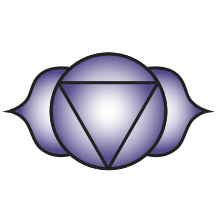Ajna

Ajna (Sanskrit: आज्ञा, IAST: Ājñā, English: "command"), or third-eye chakra, is the sixth primary chakra in the body according to Hindu tradition. It is a part of the brain which can be made more powerful through repetition, like a muscle, and it signifies the conscience. While a person's two eyes see the physical world, the third eye is believed to reveal insights about the future. The third eye chakra connects people to their intuitions, gives them the ability to communicate with the world, and helps them receive messages from the past and the future.
Location
The Ajna chakra is located in the pineal gland directly behind the center of the forehead, but its kshetram, or superficial location, is between the eyebrows at the bridge of the nose.[1] The pineal gland deep inside the brain is also associated with Ajna, as both are considered a "third eye". The location makes it a sacred spot where Hindus apply a vermilion bindi to show respect.
Appearance
Ajna is described as a transparent lotus flower with two white petals, said to represent the nadis (psychic channels) Ida and Pingala, which meet the central Sushumna nadi before rising to the crown chakra, Sahasrara. The letter "ham" (हं) is written in white on the left petal and represents Shiva, while the letter "ksham" (क्षं) is written in white on the right petal and represents Shakti.[2] These two petals also represent the manifest and the unmanifest mind, which are sometimes said to represent the pineal and pituitary glands.
Inside the pericarp of the flower is the hakini Shakti. It is depicted with a white moon, six faces, and six arms holding a book, a skull, a drum, and a rosary, while making the gestures associated with granting boons and dispelling fears. The downward-pointing triangle above her contains a white lingam. This triangle, along with the lotus flower, can represent wisdom.[3] In some systems the deity Ardhanarishvara, a hermaphrodite from Shiva-Shakti, resides within the lingam and symbolizes the duality of subject and object.
Seed syllable

The seed syllable of Ajna is Om, or "Pranava Om", which is believed to be the basic sound of the world and contains all other sounds. It is considered the supreme sound of the universe.[4] The Bīja mantras are monosyllabic seed sounds which, when they are spoken aloud, activate the energy of the chakras in order to purify and balance the mind and body. The energy resonates in the chakra associated with the mantra, helping the speaker become aware of their body's needs.[5]
| Tantric chakras |
|---|
|
Sahasrara |
Function
Ajna translates as "command" or "perceive" and is considered the eye of intuition and intellect. Its associated sense organ is the brain. When something is seen in the mind's eye, or in a dream, it is being seen by Ajna. It is a bridge that links gurus with disciples while allowing mind communication between two people. Meditation upon Ajna supposedly grants siddhi, or occult powers, to quickly enter another body at will and to become omniscient. The beholder of these powers realizes unity with Brahman, who has the ability to create, preserve, and destroy the three worlds.
As Hindus believe that spiritual energy from the environment enters their body through the Ajna chakra, they take great care to protect it with spiritually positive and protecting forces. The various religious marks on the foreheads of Hindus, for example bindis, are the spiritual gifts of their respective forms of the Hindu gods.
Directly above Ajna is a minor chakra known as Manas. This chakra is responsible for sending sense perceptions to the higher chakras. Manas has six petals, one for each of the five senses and one for sleep. These petals are normally white but take on the color of the senses when activated by them, and are black during sleep. It is associated with the parietal eye of a juvenile bullfrog.
Comparisons with other systems
- In Tibetan Buddhism this chakra is at the end of the central energy channel, which runs up the body to the top of the head,and then over and down, terminating at the forehead. The two side channels continue inward towards the two nostrils and end there. This center is frequently depicted as the third eye in artwork and is used in various meditations. There is also a forehead center above the third eye, which corresponds to the position of Manas, one of the ten chakras in the Mahayoga tantra traditions.
- In qigong, the highest Dantian is located at this position. This is one of three furnaces that converts the different types of energy in the body. In this Dantian, the spiritual shen energy is converted into wuji, the infinite space of void.
- Within the system of Lataif-e-sitta, there is a Lataif known as Khafi, or arcane subtlety, in the same position. This is thought to be related to mystical intuition. According to the Kabbalah, there are two sephirot located on the sixth level, associated with the left and right parts of the face. They are called Chokmah (wisdom) and Binah (understanding); it is at these points that the two side pillars of mercy and severity end, while the central pillar carries on rising to kether, the crown.
Alternative names
- In Tantra: Ajita-Patra, Ajna-Pura, Ajna-Puri, Ajnamhuja, Ajnapankaja, Bhru-Madhya, Bhru-Madhya-Chakra, Bhru-Madhyaga-Padma, Bhru-Mandala, Bhru-Mula, Bhru-Saroruha, Dwidala, Dwidala-Kamala, Dwidalambuja, Dwipatra, Jnana-Padma, Netra-Padma, Netra-Patra, Shiva-Padma, and Triweni-Kamala.
- In the Vedas: Baindawa-Sthana, Bhru chakra, Bhruyugamadhyabila, and Dwidala.
- In the Puranas: Dwidala, and Trirasna.
See also
References
- ↑ "The Third Eye Chakra". www.chakras.info. Retrieved 2016-04-27.
- ↑ "Sixth Chakra Third Eye Chakra Ajna Chakra". My Chakras. 2008-05-27. Retrieved 2016-05-04.
- ↑ "The Third Eye Chakra". www.chakras.info. Retrieved 2016-04-29.
- ↑ "What Does Om Mean". www.sacredfunk.com. Retrieved 2016-04-27.
- ↑ "Bija Mantras- The Sounds of the Chakras: LAM VAM RAM YAM HAM OM - ar-yoga". ar-yoga. 2011-10-11. Retrieved 2016-05-04.